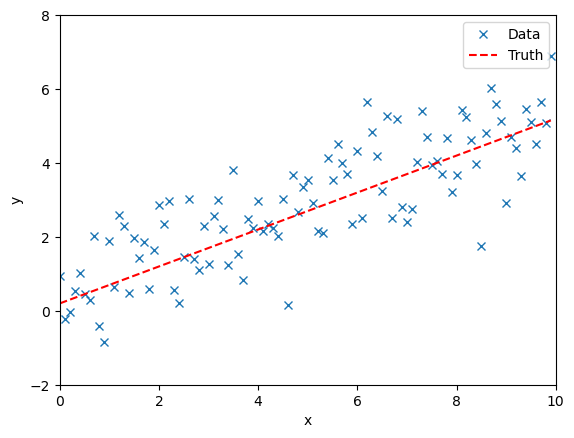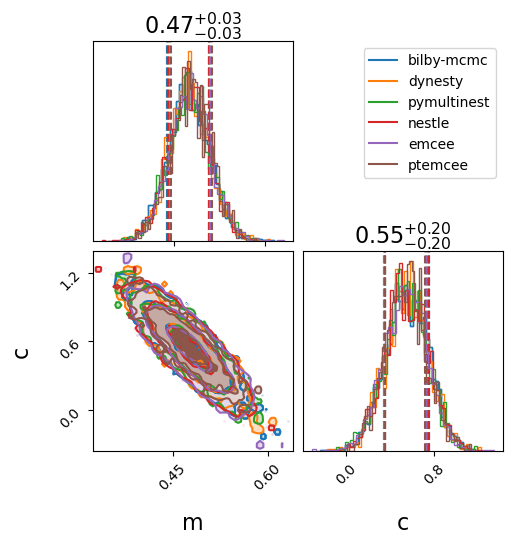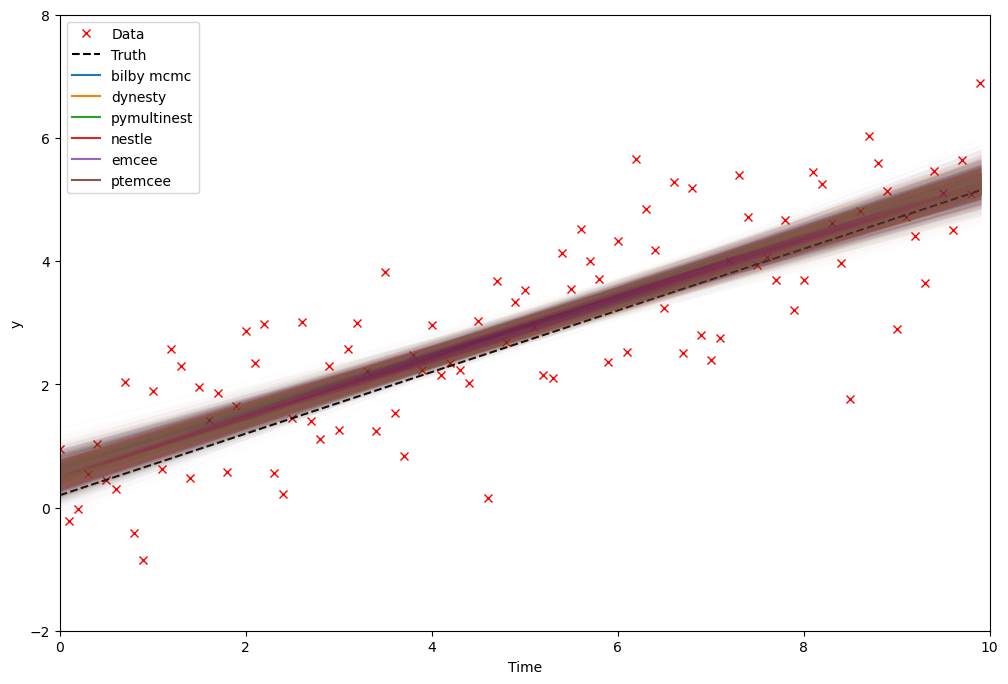Compare samplers
In this notebook, we’ll compare the different samplers implemented in Bilby on a simple linear regression problem.
This is not an exhaustive set of the implemented samplers, nor of the settings available for each sampler.
Setup
[1]:
import bilby
import numpy as np
import matplotlib.pyplot as plt
from bilby.core.utils import random
# Sets seed of bilby's generator "rng" to "123" to ensure reproducibility
random.seed(123)
%matplotlib inline
[2]:
label = "linear_regression"
outdir = "outdir"
bilby.utils.check_directory_exists_and_if_not_mkdir(outdir)
Define our model
Here our model is a simple linear fit to some quantity \(y = m x + c\).
[3]:
def model(x, m, c):
return x * m + c
Simulate data
We simulate observational data. We assume some uncertainty in the observations and so perturb the observations from the truth.
[4]:
injection_parameters = dict(m=0.5, c=0.2)
sampling_frequency = 10
time_duration = 10
time = np.arange(0, time_duration, 1 / sampling_frequency)
N = len(time)
sigma = random.rng.normal(1, 0.01, N)
data = model(time, **injection_parameters) + random.rng.normal(0, sigma, N)
fig, ax = plt.subplots()
ax.plot(time, data, "x", label="Data")
ax.plot(time, model(time, **injection_parameters), "--r", label="Truth")
ax.set_xlim(0, 10)
ax.set_ylim(-2, 8)
ax.set_xlabel("x")
ax.set_ylabel("y")
ax.legend()
plt.show()
plt.close()

Define the likelihood and prior
For any Bayesian calculation we need a likelihood and a prior.
In this case, we take a GausianLikelihood as we assume the uncertainty on the data is normally distributed.
For both of our parameters we take uniform priors.
[5]:
likelihood = bilby.likelihood.GaussianLikelihood(time, data, model, sigma)
priors = bilby.core.prior.PriorDict()
priors["m"] = bilby.core.prior.Uniform(0, 5, "m")
priors["c"] = bilby.core.prior.Uniform(-2, 2, "c")
Run the samplers and compare the inferred posteriors
We’ll use four of the implemented samplers.
For each one we specify a set of parameters.
Bilby/the underlying samplers produce quite a lot of output while the samplers are running so we will suppress as many of these as possible.
After running the analysis, we print a final summary for each of the samplers.
[6]:
samplers = dict(
bilby_mcmc=dict(
nsamples=1000,
L1steps=20,
ntemps=10,
printdt=10,
),
dynesty=dict(npoints=500, sample="acceptance-walk", naccept=20),
pymultinest=dict(nlive=500),
nestle=dict(nlive=500),
emcee=dict(nwalkers=20, iterations=500),
ptemcee=dict(ntemps=10, nwalkers=20, nsamples=1000),
)
results = dict()
[7]:
bilby.core.utils.logger.setLevel("ERROR")
for sampler in samplers:
result = bilby.core.sampler.run_sampler(
likelihood,
priors=priors,
sampler=sampler,
label=sampler,
resume=False,
clean=True,
verbose=False,
**samplers[sampler]
)
results[sampler] = result
*****************************************************
MultiNest v3.10
Copyright Farhan Feroz & Mike Hobson
Release Jul 2015
no. of live points = 500
dimensionality = 2
*****************************************************
ln(ev)= -140.58280488486835 +/- 0.10829712183050648
analysing data from /tmp/tmpu2bme8ol/.txt
Total Likelihood Evaluations: 5450
Sampling finished. Exiting MultiNest
[8]:
print("=" * 40)
for sampler in results:
print(sampler)
print("=" * 40)
print(results[sampler])
print("=" * 40)
========================================
bilby_mcmc
========================================
nsamples: 1449
ln_noise_evidence: nan
ln_evidence: -137.706 +/- 0.035
ln_bayes_factor: nan +/- 0.035
========================================
dynesty
========================================
nsamples: 1329
ln_noise_evidence: nan
ln_evidence: -140.519 +/- 0.135
ln_bayes_factor: nan +/- 0.135
========================================
pymultinest
========================================
nsamples: 1746
ln_noise_evidence: nan
ln_evidence: -140.583 +/- 0.108
ln_bayes_factor: nan +/- 0.108
========================================
nestle
========================================
nsamples: 4295
ln_noise_evidence: nan
ln_evidence: -140.465 +/- 0.107
ln_bayes_factor: nan +/- 0.107
========================================
emcee
========================================
nsamples: 8380
ln_noise_evidence: nan
ln_evidence: nan +/- nan
ln_bayes_factor: nan +/- nan
========================================
ptemcee
========================================
nsamples: 1020
ln_noise_evidence: nan
ln_evidence: -144.380 +/- 19.364
ln_bayes_factor: nan +/- 19.364
========================================
Make comparison plots
We will make two standard comparison plots.
In the first we plot the one- and two-dimensional marginal posterior distributions in a “corner” plot.
In the second, we show the inferred model that we are fitting along with the uncertainty by taking random draws from the posterior distribution. This kind of posterior predicitive plot is useful to identify model misspecification.
[9]:
_ = bilby.core.result.plot_multiple(
list(results.values()), labels=list(results.keys()), save=False
)
plt.show()
plt.close()

[10]:
fig, ax = plt.subplots(figsize=(12, 8))
ax.plot(time, data, "x", label="Data", color="r")
ax.plot(
time, model(time, **injection_parameters), linestyle="--", color="k", label="Truth"
)
for jj, sampler in enumerate(samplers):
result = results[sampler]
samples = result.posterior[result.search_parameter_keys].sample(500)
for ii in range(len(samples)):
parameters = dict(samples.iloc[ii])
plt.plot(time, model(time, **parameters), color=f"C{jj}", alpha=0.01)
plt.axhline(-10, color=f"C{jj}", label=sampler.replace("_", " "))
ax.set_xlim(0, 10)
ax.set_ylim(-2, 8)
ax.set_xlabel("Time")
ax.set_ylabel("y")
ax.legend(loc="upper left")
plt.show()
plt.close()

[ ]: